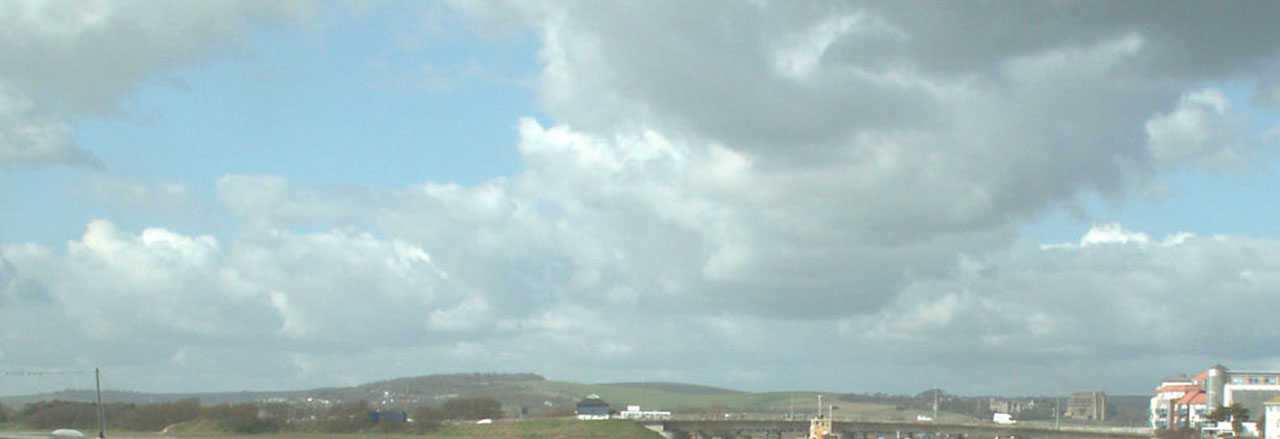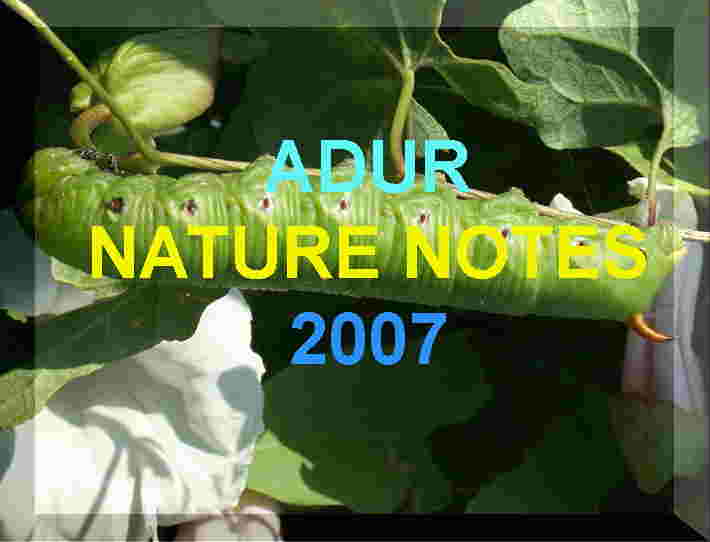|
LOCAL
NATURE RESERVES

A
Nature
Reserve is defined in Section 15 of
the National Parks and Access to the Countryside Act 1949,
as land managed for the purpose:
(a)
of providing, under suitable conditions and control, special opportunities
for the study of, and research into, matters relating to the flora and
fauna of Great Britain and the physical conditions in which they live,
and for the study of geological and physiographical features of special
interest in the area; or
(b)
of preserving flora, fauna, or geological or physiographical features of
special interest in the area; or for both these purposes.’ |
EVENTS
7 January
2009
Wildlife of the
South Downs
A presentation and discussion
Illustrated talk by Andy
Horton
Explore
the south downs above the Adur Valley through the eyes of wildlife writer
and photographer Andy Horton, a native Shoreham resident. The chalk downs
are noted for their flowering herbs and the famous butterfly sites at Anchor
Bottom and Mill Hill.
Venue:
Beeding and Bramber Village Hall which is in Upper Beeding High Street.
WILDLIFE
REPORTS
9 November
2009
As
expected it was almost a complete miss for butterflies
on Mill Hill, but in the north-west corner
of Mill Hill Nature Reserve I almost stumbled
over a Clouded Yellow Butterfly which
fluttered on to the Old Erringham pasture and when I almost trod on it
it flew over the Hawthorn
scrub in the direction of the lower slopes of Mill Hill. It
was only positive butterfly sighting of the day and the last butterfly
of the year.
Adur
Butterfly List 2009
2 November
2009
When
the sun emerged from from behind the frequent clouds a Peacock
Butterfly emerged from hibernation by
the Ivy on the edge of the Pixie Path, looking
slightly tatty. Four Common
Blue Butterflies were seen at the northern
end of the lower slopes of Mill Hill;
both these records were the first for the month of November.
There was also a probable Large White
in Shoreham town which would also be a first
for the month.
On
Mill Hill, two Clouded Yellows
courted and then mated and this was also the first time that this has been
seen locally. Over the Waterworks Road
a large female Sparrowhawk
swooped between the trees and it may have after the frequent Wood
Pigeons.
Full
Butterfly Report
Adur
Butterfly Flight Times
 26
October 2009 26
October 2009
I
thought I was going to draw a complete blank on the lower slopes of Mill
Hill, when a pure white black lined Clouded
Yellow fluttered rapidly past. This was the
first time I had seen a completely white one and I have identified this
as a female Clouded Yellow var. Helice,
which would be a first for Mill Hill and Shoreham. Then to my surprise
a nearly new male Adonis Blue
was spotted on a single Devil's Bit Scabious
flower
its presence preventing a female
Common
Blue
from landing. Seven species of butterfly,
including three other Clouded Yellows,
were seen on an overcast day.
Full
Butterfly Report
12
October 2009
Life
for the declining number of butterflies
was beginning to becoming more difficult. The Ivy was still an attractant
but everywhere the bushes were dominated by swarms of wasps,
bees and flies with the occasional bumblebeeand
the butterflies if they were able to find a perch it was an even chance
that it would be right at the top of the bush. Predatory dragonflies
were frequently seen, mostly Common Darters,
but also at least one Southern Hawker.
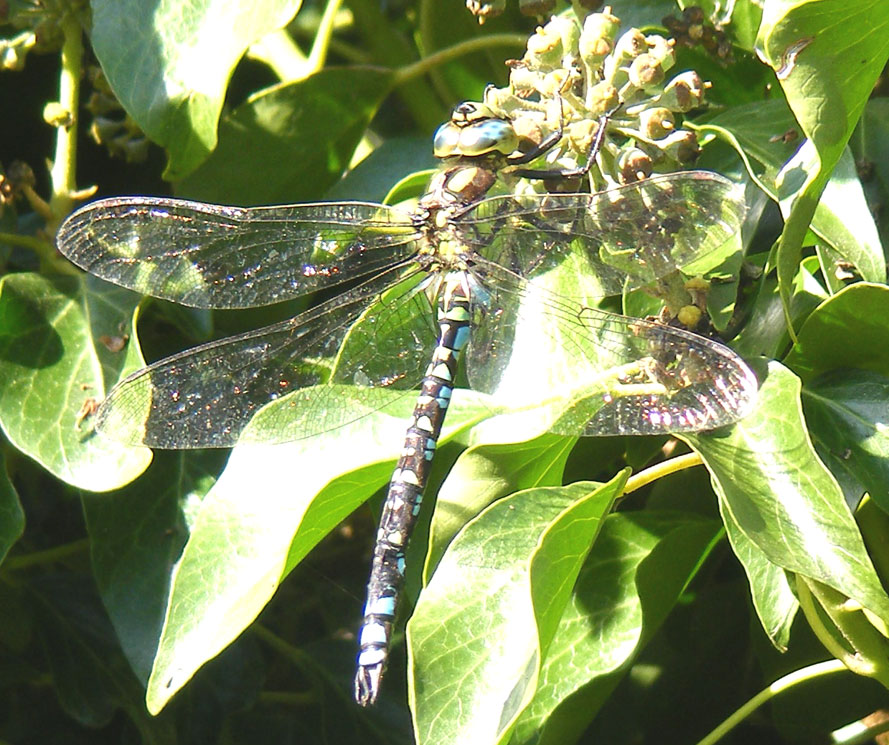
|
 |
|
Southern
Hawker
|
Clouded
Yellow
|
Red
Admirals were the only butterfly that
were numbered in double figures with 13 or 14. Twelve
butterfly species were seen on the day including
at least five, possibly as many as eight Clouded
Yellows, one of which was seen to settle
on purple nectaring flowers. At
least half of the six male Common Blues
on the lower slopes of Mill Hill were in a very fresh condition.
Full
Butterfly Report
10-11
October 2009
A
juvenile Common (or Harbour) Seal,
Phoca
vitulina, was seen swimming in the River
Adur estuary
by the Surry Hard, near where some of the smaller fishing boats are moored.
On the second day the seal was reported by Andrew
Bellamy in the river at Upper Beeding. Seals
are a rare sight off the mid-Sussex coast, but a few have been seen off
Shoreham
Beach before. The nearest rookery is a small group of seals in Chichester
Harbour which are occasionally seen around Selsey
(Seal Island).
BMLSS
Seals
Previous
Sighting in 2008
10
September 2009
An
early morning low tide visit to Kingston
Beach, Shoreham with Tiger
Aspect Productions Ltd, to film the Blenny
sequence for a TV four programme series called
The
Seasons with Alan Titchmarsh,
recorded the expected Blennies,
Lipophrys
pholis, a large Rock
Goby, Gobius paganellus,
half a dozen large Edible Prawns, Palaemon
serratus, and a notable a young green
Ballan
Wrasse, Labrus bergylta.
25
August 2009
On
a breezy day, the one acre transect on the lower slopes of Mill
Hill hosted 38 Adonis
Blue Butterflies with the 17 females the
highest recorded count for this gender.
Full
Butterfly Report
17
August 2009
I
was shocked by the unmistakable sighting of a Brown
Hairstreak Butterfly*
on Mill Hill south of the upper car park.
It flew of rapidly and was lost to my sight in about 20 seconds, so this
was my first ever glimpse of hedgerow
butterfly
that lays its eggs on Blackthorn (Sloe). This
has increased the total species seen in Shoreham and all on Mill Hill to
33. Nineteen species of butterfly seen on the day
on Mill Hill and the Adur Levels including 54
Adonis
Blues.
*Later
doubts have crept in about the identification of this butterfly. I did
not get a good enough look to be 100% certain.
Full
Butterfly Report
12
August 2009
Something
made me look up towards the cloudy sky over the northern slope of Anchor
Bottom: a large dark bird glided through the sky and by its broad wing
shape I recognised a Buzzard.
Less than a minute afterwards it was mobbed by a Crow,
but it glided westwards unperturbed and then out of sight. A flock of thirty
or more Rooks
were seen in the same area, followed by flock of 200+ Starlings
that
flew up in unison as the Buzzard
glided past.
3 August
2009
The
sun was out, but alas not the Chalkhill
Blues in their expected numbers on Mill
Hill with just 47 noted which means that the number of the Chalkhill
Blues in flight on Mill Hill were probably
around 150 which is a disastrously low total.
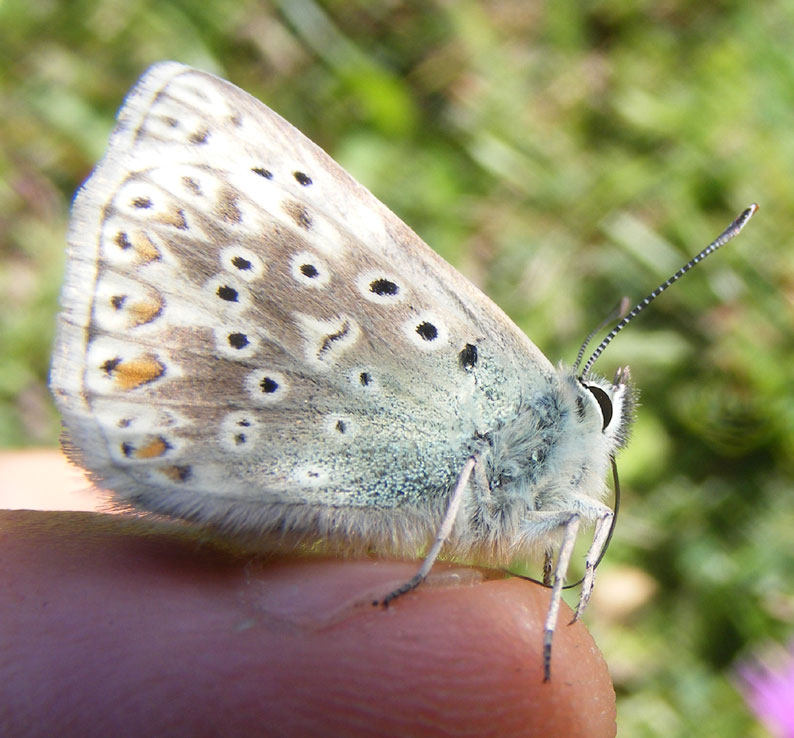 |
This
Chalkhill
Blue appeared to be ill or poisoned and
it could he handled. This has been seen before in previous years. |
There
were well over a hundred Common Blues
on
the meadows to the north of the northern car park on Mill Hill with frequent
Painted
Ladies all over the hill, about ten Peacock
Butterflies, a surprise Brimstone
Butterfly, and just two fresh first of
the year Essex Skippers
(could have been Small Skippers).
The
variety of butterfly species was fine with
twenty species recorded which was the second best day total ever. The
list included my first
Small Copper
of the year on Anchor Bottom.
Full
Butterfly Report
List
of Species
Adur
Butterflies: First Dates
31
July 2009
The
weak sun sun shone through the white cumulus
clouds in a bright blue sky on what should have been a peak day for
the Chalkhill Blue Butterflies,
but only 51 were counted in in the one acre transect on the lower slopes
of Mill Hill. There were probably only
about a hundred Chalkhill Blues
on Mill Hill. The Chalkhill
Blue count was very poor as in a poor year
200 would be recorded in the transect acre and 750+ in a good year. This
would compute to 500 and 3000+ on Mill Hill as a day count.

The
first mating pair of Chalkhill Blues was seen on the Mill Hill Cutting
On
the plus side fresh Wall Browns
put in a good show with six seen on the day and I
would expect a dozen or more would have been noted if I had visited to
the middle and upper parts of Mill Hill.
Full
Butterfly Report
23
July 2009
Under
a cloudy sky my first female Chalkhill
Blue Butterfly of the year was blown about
in the breeze, with a count of 24 males
in unfavourable conditions on the lower slopes of Mill
Hill. The highlight of the day, as the sun and vanessid
butterflies
came out along the Coastal-Downs Link Cyclepath
between Upper Beeding and Old Shoreham, was the first
Hummingbird
Hawk-moth since 2006
whirring away amongst the meadow herbs on the edge of the verges, its orange
rear and vibrating wings most distinctive.
Greater
Knapweed Meadow (Image)
Knapweed
Studies
14
July 2009
A
visit to Tottington Woods, Small Dole, with
Jan
Hamblett, resulted in the sightings of
two butterflies not recorded personally in
the Lower Adur Valley area before.

|
 |
|
Silver-washed
Fritillary
|
White
Admiral
|
There
were frequent flights under the canopy of Oak
and
Willow
of
the large and splendid
Silver-washed Fritillaries
flying up to about five metres above the ground vegetation and wood piles
and occasionally landing for a photograph. Two splendid White
Admirals
were spotted, the first one slightly
worn and intact, and the one that landed in front of us was damaged with
two chunks missing out of its left forewing. The first confirmed Migrant
Hawker (dragonfly)
of the year was seen in a woodland ride in Tottington
Wood.
Full
Butterfly Report
Adur
Butterfly Flight Times
Adur
Dragonflies 2009
25
June 2009
A
metre long Bluefin Tuna, Thunnus
thynnus, jumped 30 cm clear of the sea in
the vicinity of a fishing boat seven miles off Shoreham-by-Sea,
Sussex, in the early afternoon on a sunny day. It was speculated that this
tunny (which is now rare in British seas)
followed the large shoals of fish in, which in turn attracted the fishing
vessel. "As it left the water I was able to catch sight of its gleaming
multi-coloured sides of the the torpedo-shaped fish and the small pre-caudal
triangular finlets appeared dark blue. Its weight was estimated to be about
12 kg."
BMLSS
Tunnies
In
the late afternoon, two Wall
Lizards, Podarcis
muralis, were seen on the flint walls of the Old Fort, Shoreham
Beach. Both were green intact adults and the first one stayed around
long enough for a photograph.
Adur
Lizards

Near
the Old Fort, the expanse of Starry Clover,
Trifolium
stellatum, flowering was coming to
an end. Childing Pink, Petrorhagia
nanteuilii, was present in small numbers,
all with single flowers in their usual place in a small patch at Silver
Sands.
New
Wild Flowers
22
June 2009
A
cycle ride from Old Shoreham to Annington
Sewer along the Coastal-Downs
Link Cyclepath produced frequent butterflies
including at least two of my first Ringlet
Butterflies of the year and six other
butterfly species.
The
most interesting observations of the day occurred at Annington
Sewer where a large blue dragonfly flew
over the stream and it looked subtly different from a Southern
Hawker and may very well have been a male
Emperor
Dragonfly. Unfortunately, it quickly flew
out of sight.

Its
display was excelled by a pair of Banded Demoiselles, Calopteryx
splendens, that danced over the stream for a full ten minutes and
probably longer. They appeared to be courting, but both of the wings had
bright blue patches whereas the female has wings of metallic green. Interestingly
there was a resting emerald green damselfly
(illustrated
above) of about the same size which may have
been a female of the species.
 Full
Butterfly Report Full
Butterfly Report
Adur
Dragonflies 2009
Full
Dragonfly and Damselfly Report
New
Wild Flowers
8 June
2009
The
orchid
(illustrated on the right) discovered on the Mill
Hill Cutting (south-west) was a mystery.
There
are seven votes
for the Southern Marsh Orchid, Dactylorhiza
praetermissa.
New
Wild Flowers
7 June
2009
A
female Stag Beetle, Lucanus cervus,
crawled
across the pavement of Buckingham Road, Shoreham, just north of the junction
with Nicolson Drive.
Adur
Beetles
Male
Stag Beetle 2009
26
May 2009
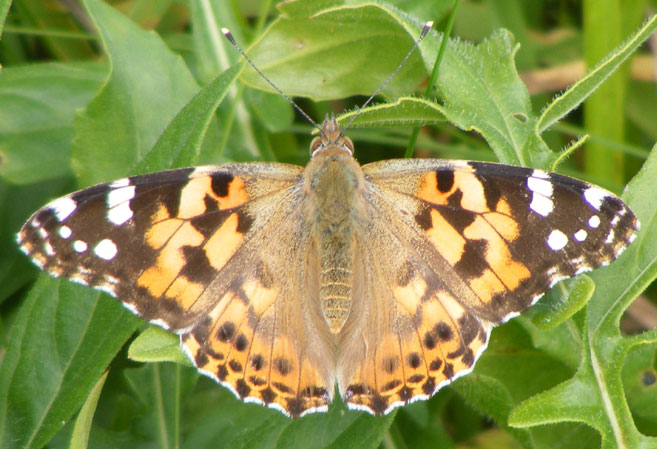
The
mass immigration of Painted Lady Butterflies
was
astonishing, throughout the morning over east Shoreham, Southwick and Portslade
the Painted Ladies exceeded
two a minute for an hour and were over one a minute the rest of the time,
with large numbers (100+) in Portslade Cemetery and on the main road that
traversed Hove Cemetery, the butterflies
flew across the road at over 30 every minute for five minutes in passing.
The conservative estimate was at least 500 seen as I cycled along the urban
roads. Their estimated speed was 8 mph although some seemed to have lost
their sense of steady northerly migration. Occasionally a Large
White Butterfly was spotted.
Painted
Lady Influx on UK Butterflies
17
May 2009
On
the lower slopes of Mill Hill, the Horseshoe
Vetch,
Hippocrepis comosa,
was at its peak on a blustery overcast day. My first Painted
Lady Butterfly of the year was recorded
along with 29 Adonis
Blues
and
eight
butterfly
species in total on Mill Hill and its approaches.

Full
Butterfly Report
Flowering
Dates of Horseshoe Vetch
Adur
Butterflies: First Dates
23
April 2009
My
first ever confirmed Green Hairstreak Butterfly was discovered on
Mill
Hill in the central area of the lower slopes by the path.
I had suspected sightings in the same area before and this butterfly
had been reported by other visitors. My first
Wall
Brown Butterfly of 2009
was seen over the path approach to the copse from the north-west in an
area this butterfly had been seen regularly in previous years. Eleven
species of butterfly were seen on the day and this excluded two species
that could have been expected.
A
flock of seven Swallows
flew over the River Adur
south of Cuckoo's Corner.
Full
Butterfly Report
20
April 2009
At
first it looked like a discarded leather belt, but a closer look established
it was a dark blue and black snake
coiled up on an earth bank on the side of the bridlepath (from the Sussex
pad to Lancing Ring) by a field of Cowslips
west of Hoe Cottage, north Lancing next to the downs. I later confirmed
the snake with back diamond-shaped markings to be an Adder
(or European
Viper), Vipera
berus,
the very first one I had seen in my life.
By the time I had recognised the reptile it managed to slither into the
grass and it disappeared from view. It appeared to be a juvenile, much
smaller than any Grass Snakes I had seen locally. Its head was small and
would only seem capable of catching and swallowing insects or young mice.
 19
April 2009 19
April 2009
A
morning visit to Mill Hill on a dull day
produced just a smattering of butterflies:
a handful (about five) of Grizzled Skippers,
my first Dingy Skipper of
the year, two whites probably Small Whites,
two good condition Peacock Butterflies
and a Treble-bar Moth (that
landed on me) on the lower slopes. The scrub produced two more whites including
a Large White
and three Speckled Woods.
The most representative feature of the lower slopes were the frequency
(15+) of the small pyralid
moth
Pyrausta nigrata plus at least one
Pyrausta
despicata.
A
large Dryad's Saddle
was spotted on a log by the path that runs along the south of Frampton's
Field, Old Shoreham.
Dryad's
Saddle Image
Adur
Fungi 2009
15
April 2009
We
visited Mill Hill where we met Neil
Hulme and saw between 20 and 30 Grizzled
Skippers and newly emerged Dingy
Skippers.
Adur
Butterflies: First Dates
Adur
Skippers
 14
April 2009 14
April 2009
Two
small day-flying in moths put in their first appearance
of the year on the lower slopes of Mill Hill
(Old Shoreham): these were the pyralids,
three
Pyrausta despicata
and two Pyrausta nigrata.
Two Grizzled Skippers
were recorded.
The
first yellow Horseshoe Vetch, Hippocrepis
comosa, flowers appeared on the lower
slopes of Mill Hill, hosting small black pollen
beetles, Meligethes erichsoni.
Flowering
Dates of Horseshoe Vetch
13
April 2009
In
the late afternoon, my first Holly Blue
Butterfly of the year was seen fluttering
over a garden overlooking the Waterworks
Road.
7 April
2009
My
first Swallow of
2009 flew over the Cuckoo's
Corner inlet at
10:40 am.
6 April
2009
Two
further butterflies put in their first appearances
of the year: a single Speckled Wood
in the copse on top of Mill Hill, and a
male Orange-tip Butterfly
over the verges of Waterworks
Road. Nine species of butterfly were seen,
the most species in a single day so far this year.
Full
Butterfly Report
Adur
Butterflies: First Dates
5 April
2009
There
were frequent Dotted Bee-flies, Bombylius
discolor, hovering in mid-air
and visiting Ground Ivy
on the Coastal Link Cyclepath near the Cement
Works.
Adur
Dotted Bee-flies 2009
Dotted
Bee-flies Information
30
March 2009
The
first Grizzled Skipper
of the year seen on the lower slopes of Mill
Hill was a great surprise and the first one recorded in March.
I also recorded my first Small Tortoiseshell
of 2009 with
two of them visiting the violets
in the same location.

Seven
species of butterfly were recorded in the
sunshine.
Full
Butterfly Report
Adur
Butterfly Flight Times
Adur
Butterflies: First Dates
Adur
Skippers
29
March 2009
An
unexpected treat was three or four individual Dotted
Bee-flies, Bombylius
discolor, using their long feeding
tubes to take nectar on a large patch of Ground
Ivy, Glechoma hederacea.

This is
a notable record of a rarely recorded fly and is probably the first for
Lancing. Bombylius discolor is
a declining BAP (Biodiversity
Action Plan) species. In Great Britain this species is classified as
Nationally
Scarce.
UK
Known Distribution (165 squares)
Adur
Flies 2009
Previous
Record on Mill Hill
A trampled
version of the Crow Garlic
or Wild Onion,
Allium
vineale,
was seen on the Pixie Path and it is an addition
to the Flora
of Shoreham-by-Sea (List).
11
March 2009
My
first reptile of 2009
was
one of five Wall Lizards, Podarcis
muralis, basking for a brief view
on the south-facing flint surround wall of the Old Fort, Shoreham
Beach, before skitting off into the grass growing up next to the wall.
Two of the lizards were grey coloured small juveniles.
8 March
2009

My first
butterfly
seen this year was a Red Admiral
induced out of hibernation by the weak sunshine over the grass and the
edges of the copse at the top of Chanctonbury Drive,
south-east of the bridge over the A27
to Mill Hill.
Adur
Butterfly List 2009
12
February 2009
An
immigrant male Merlin
landed on a pylon* near the Power Station Chimney in Shoreham Harbour (by
Southwick
Beach) and it was quickly pounced upon by one of the resident
Peregrine
Falcons. "I saw one of the Peregrines hurtling towards
the
pylon with my naked eye. I looked straight back through the scope, expecting
to see an almighty tussle, but incredibly the Peregrine was perched on
the Merlin, the
latter still struggling and flapping wings, and the Peregrine keeping balance
with wings outspread. After one unsuccessful attempt at flying with its
prey still putting up a fight, the Peregrine managed to subdue the Merlin
and flew away further into Southwick somewhere (being lost behind the houses)
still clutching the Merlin.
(*A
frequent perch of one of the two resident Peregrines.)
28
January 2009
An
Iceland
Gull, Larus
glaucoides, was seen at 8:50
am on Southwick
Beach just west of the power station. It was a large individual with
a pretty large bill. It was seen again by Carat's
Cafe at 10:00
am.
Iceland
Gull Sussex Records
7 January
2009
The
air temperature recorded in Shoreham at 4:00
am at minus 6.9 °C was the lowest
this millennium.
Shoreham
Weather (Met Office)

Mute
Swans showing the depth of the Ice on Widewater
Photograph
by David Wood
Widewater
Lagoon froze over, with the ice thick enough to support the weight
of a Mute Swan.
Report
by Gordon Croucher (Lancing Parish Council)
6
January 2009
The
air temperature recorded in Shoreham at 8:00
am at minus 5.7 °C was the lowest
this millennium.
Shoreham
Weather (Met Office)
1 January
2009
The
first bird of the year seen was an unidentified gull, probably a Herring
Gull on the roof opposite my window in
Corbyn Crescent, the residential part of Shoreham-by-Sea, followed by a
handful of Starlings and looking out over the back garden, a small
flock of House Sparrows
congregated in the high shrubbery.
|
